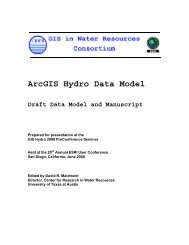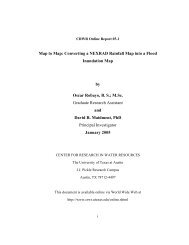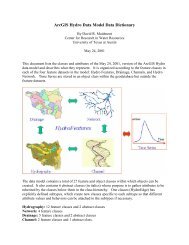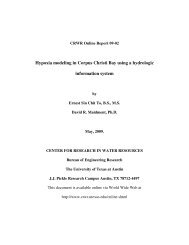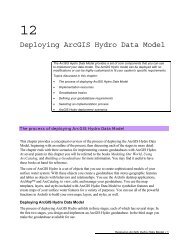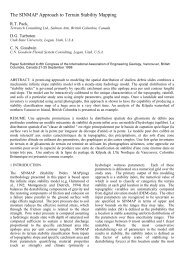View the Whole Report - Center for Research in Water Resources ...
View the Whole Report - Center for Research in Water Resources ...
View the Whole Report - Center for Research in Water Resources ...
You also want an ePaper? Increase the reach of your titles
YUMPU automatically turns print PDFs into web optimized ePapers that Google loves.
<strong>the</strong> difference between measured and predicted flow rates is caused by sediment clogg<strong>in</strong>g<br />
<strong>the</strong> fabric open<strong>in</strong>gs.<br />
The woven Mirafi fabric exhibited such clogg<strong>in</strong>g after a series of tests with clean<br />
water (probably from scour of <strong>the</strong> sand). In subsequent flume tests <strong>the</strong> fabric behaved as<br />
if it were clogged from <strong>the</strong> beg<strong>in</strong>n<strong>in</strong>g. This sample was designated Mirafi A and ano<strong>the</strong>r<br />
sample, Mirafi B, was placed <strong>in</strong> <strong>the</strong> flume <strong>in</strong> order to observe <strong>the</strong> per<strong>for</strong>mance of clean<br />
fabric. The flow rates given <strong>for</strong> <strong>the</strong> Mirafi fabric <strong>in</strong> Table 5.5 are those of <strong>the</strong> B sample.<br />
Runoff did not flow through approximately 2 cm of <strong>the</strong> upper portion of <strong>the</strong> silt<br />
fence fabrics dur<strong>in</strong>g <strong>the</strong> tests. This behavior also was noticed by Crebb<strong>in</strong> (1988) <strong>in</strong> his<br />
experiments.<br />
Table 5.5 Flow per Area of Silt Fence ( L/s . m 2 ) as a Function of Head<br />
Head, m Belton w Exxon w Mirafi B nw Amoco w<br />
0.15 2.4 0.38 0.39 5.8<br />
0.30 5.5 0.82 NA NA<br />
The hydraulic behavior of <strong>the</strong> rock berm <strong>in</strong> all of <strong>the</strong> flume tests was practically<br />
identical, <strong>in</strong>dicat<strong>in</strong>g that <strong>the</strong>re was no clogg<strong>in</strong>g. A steady state level was ma<strong>in</strong>ta<strong>in</strong>ed by<br />
<strong>the</strong> rock berm <strong>for</strong> all five tests at <strong>the</strong> maximum possible flow rate <strong>in</strong> <strong>the</strong> flume (90<br />
L/s . m 2 ). The average steady state level was 0.06 m. Approximately 0.4 m of rock berm<br />
was not submerged. TxDOT (1992a) recommends a maximum flow rate of 40 L/s . m 2 ,<br />
which is greatly exceeded <strong>in</strong> berms constructed accord<strong>in</strong>g to <strong>the</strong> TxDOT design criteria.<br />
5.1.7 Determ<strong>in</strong><strong>in</strong>g Detention Times <strong>for</strong> Flume Tests<br />
Detention times were calculated <strong>for</strong> each test of <strong>the</strong> silt fences and rock berm and<br />
are provided <strong>in</strong> Appendix D. An average detention time, T avg , was determ<strong>in</strong>ed <strong>for</strong> each<br />
∆V of runoff pass<strong>in</strong>g through <strong>the</strong> controls. A volume-weighted detention time, T d , <strong>for</strong><br />
each test was calculated by:<br />
T<br />
d<br />
=<br />
∑ Tavg∗<br />
∆V<br />
∑ ∆V<br />
44




